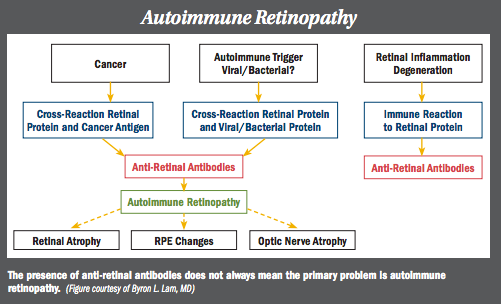Article
Autoimmune retinopathy: While uncommon, viable option for unexplained vision loss
Ophthalmologists should suspect autoimmune retinopathy if a patient presents with an unexplained visual loss.
Take-home message: Ophthalmologists should suspect autoimmune retinopathy if a patient presents with an unexplained visual loss.
By Vanessa Caceres; Reviewed by Byron L. Lam, MD
Miami- Autoimmune retinopathy may not be that common, but clinicians should keep the diagnosis in mind when a patient presents with unexplained visual loss, reported Byron L. Lam, MD.
Autoimmune retinopathy is broken down into three different categories:
- paraneoplastic retinopathy, which includes recoverin-associated retinopathy and melanoma-associated retinopathy;
- non-paraneoplastic autoimmune retinopathy;
- combined paraneoplastic optic neuropathy and retinopathy.
An example of the latter category includes IgG against collapsing response-mediator protein (CRMP-5).
Worst places to practice medicine this year
“There are many other yet undefined causes we don’t know about yet,” said Dr. Lam, holder of the Robert Z. and Nancy J. Greene Chair in Ophthalmology, Bascom Palmer Eye Institute, University of Miami Miller School of Medicine, Miami.

Dr. Lam outlined the various triggers for autoimmune retinopathy, including cancer and autoimmune causes. With cancer, a cross-reaction between the retinal protein and cancer antigen may occur, leading to anti-retinal antibodies. That leads to autoimmune retinopathy, which often manifests as retinal atrophy, retinal pigment epithelium changes, and optic nerve atrophy.
Read more clinical diagnosis news
When there is a non-paraneoplastic autoimmune trigger, a potential mechanism may be a cross-reaction between the retinal protein and viral or bacterial protein, leading again to anti-retinal antibodies and autoimmune retinopathy. In addition, retina degeneration, itself from other causes, may lead to an immune reaction to retinal proteins and secondary anti-retinal antibodies.
Beware of symptoms
Some symptoms of autoimmune retinopathy include subacute painless visual loss. The visual loss is associated with scotomas, photopsias, nyctalopia, dyscrhomatopsia, and photoaversion, Dr. Lam said.
Next: 'Just looking at the retina may not do it'
Signs appear bilaterally, and the fundus can initially appear normal. At a later stage, the patient may show retinal atrophy, vascular attenuation, and disc pallor. Using optical coherence tomography and autofluorescence may help to evaluate the patient better.
“Just looking at the retina may not do it,” added Dr. Lam. “You should go ahead and use other diagnostic tests.”
If you suspect autoimmune retinopathy, Dr. Lam advised starting with a detailed history.
Read the latest on vision loss
For example, patients with previous small cell lung, gynecologic, and breast cancers, as well as melanoma, are likely to develop the condition. A history of autoimmune disease, hereditary retina degeneration, or inflammatory retinopathy–such as acute zonal occult outer retinopathy–are important to identify other retinal conditions that mimic autoimmune retinopathy.
A key test for autoimmune retinopathy is the full-field electroretinogram (ERG), Dr. Lam said. He recommended following the ERG testing standards set forth by the International Society for Clinical Electrophysiology of Vision. He also cautioned that it may be more difficult to interpret the findings in older patients, as ERG declines with age but the range of what is normal increases with patient’s age. Clinicians can repeat the full-field ERG to assess progression or also perform a multifocal ERG if needed.
Other tests
Other ways to test for autoimmune retinopathy include retinal antibody testing and performing a work-up for cancer.
If the ERG results show the cones are primarily affected, Dr. Lam said to consider anti-enolase syndrome.
Top-paying states for ophthalmic techs
“Autoimmune retinopathy is tricky because patients without a history of cancer can develop autoimmune retinopathy,” explained Dr. Lam. “Some normal subjects may test positive for anti-retinal antibodies. We still don’t know as much as we like to know about the spectrum of autoimmune retinopathies.”
Next: Advice
If performing anti-retinal antibody testing, Dr. Lam advised using a CLIA lab and testing for specific antibodies, such as recoverine, enolase, CRMP-5, arrestin, aldolase, glyceraldehyde-3-phosphate, dehydrogenase, and carbonic anhydrase II. The 23-kDA protein antibody must be verified using a purified recoverin on Western blot to verify presence of anti-recoverin antibodies, he added.
PR tips to guarantee a highly regarded practice
A diagnosis of autoimmune retinopathy is supported if there is one of the specific antibodies noted above that are associated with paraneoplastic retinopathy.
“Nonspecific anti-retinal antibodies may imply autoimmune retinopathy–or may be the physiologic results of retinal degeneration from other causes,” Dr. Lam said.
Byron L. Lam, MD
This article was adapted from Dr. Lam’s presentation during the 2014 meeting of the American Academy of Ophthalmology. Dr. Lam did not indicate any proprietary interests related to the topic.
Newsletter
Don’t miss out—get Ophthalmology Times updates on the latest clinical advancements and expert interviews, straight to your inbox.




